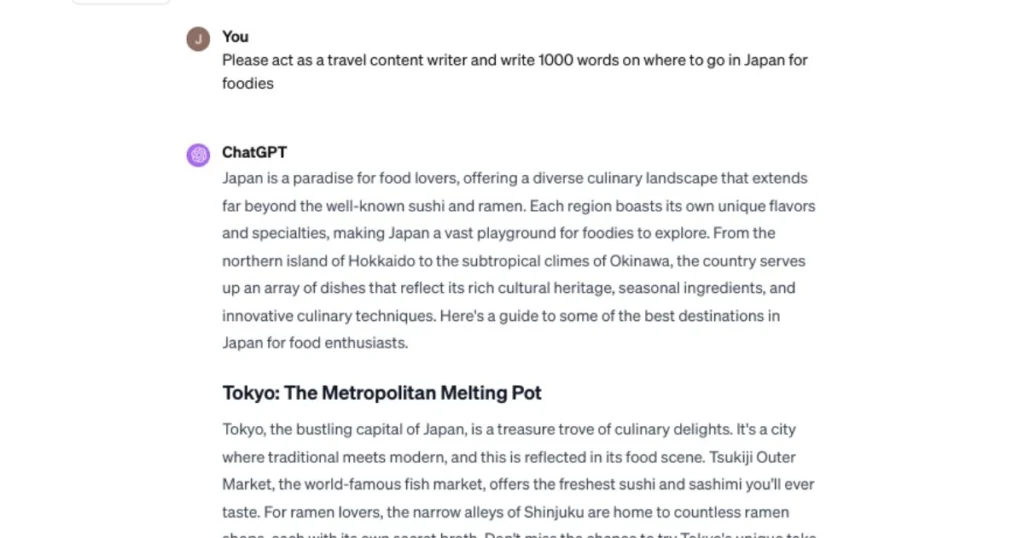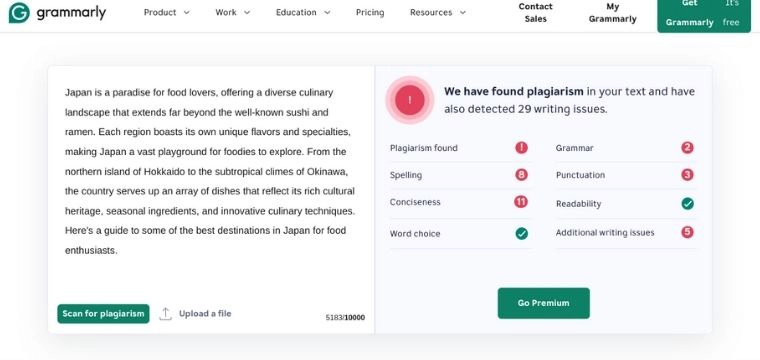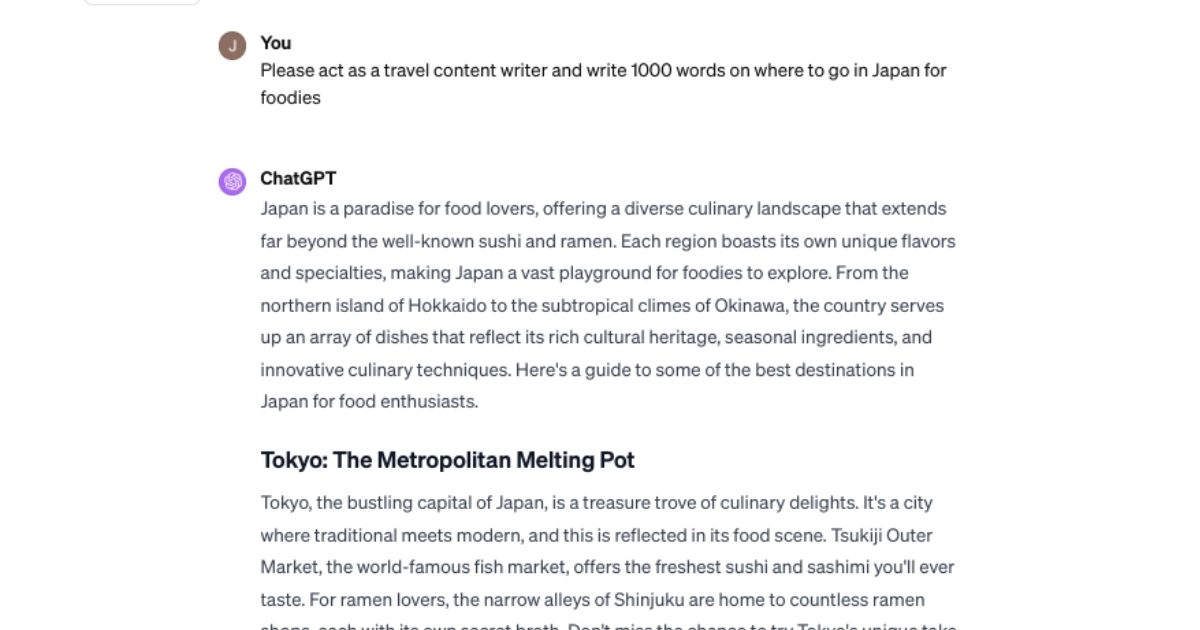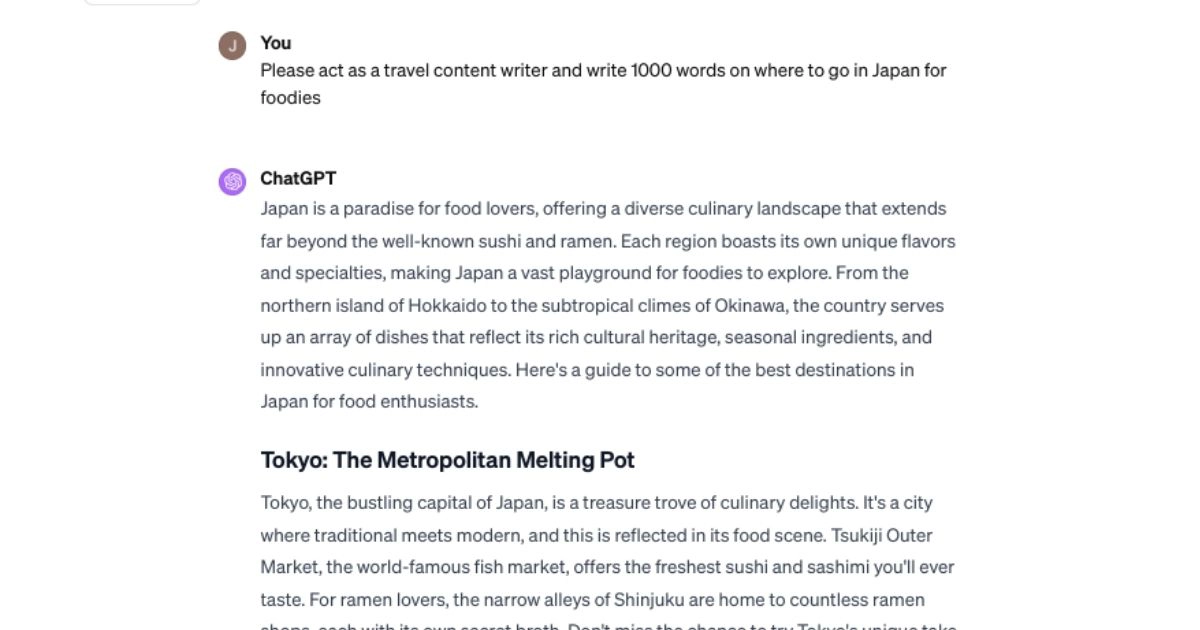
Jay Harlow
Travel Copywriter
Table of Contents
A travel copywriter’s experience from a year of using ChatGPT
In this post, I want to share with you what I’ve learned about using ChatGPT as a travel copywriter. You’ll read my first-hand experiences of using the robot to write travel copy – and ways to get round the pitfalls of AI-generated content.
I have so many learnings I want to share, that they can’t possibly all fit in the same post. So this is part 1. Stay tuned to my social media for when I release part 2.
Just a heads up, my learnings are actually quite negative about using AI for content creation. I love the tool for productivity. It’s great at automating admin tasks and speeding up research. But, as an experienced copywriter and travel industry professional, I don’t rate it for writing content. Here’s why…
ChatGPT plagiarises content nearly every time
Did you know the New York Times has filed a lawsuit against OpenAI for plagiarism? ChatGPT literally copied their content, and changed just one or two words. And it does this a lot, especially if your prompt isn’t that detailed.
You see, AI doesn’t actually “create” content, it generates it based on the data it has. You’ll often find it reproduces content that’ anyone can find on Google and just changes a random word.

It’s obvious why this is such a problem. For a start, legal issues. Secondly, it’s likely your customers are also looking at your competitors’ content, too. So ask yourself this. How would it come across to them to see you’ve word-for-word copied someone else’s work? You’d look pretty crappy, wouldn’t you? Then there’s the whole SEO side of things. You won’t rank with regurgitated content, (read Google’s guidelines here) so what’s the point of even publishing it?
How can you get around this in your travel copywriting?
Every time you produce content with AI, run it through a plagiarism checker. EVERY SINGLE TIME.
And I’ve got bad news for you here. From a year of using it, I’ve found nearly every piece of long content (400+ words) it produces is plagiarised. You’ll then need to either cite the source or rewrite it considerably. Otherwise, you’ll be in trouble, my travel marketer friend.
So how do you check for plagiarism? With an online detector. In my opinion, Grammarly’s plagiarism checker is the best free tool. Keep in mind, though, that the free tools often don’t tell exactly what’s been copied and where from. So if you use a free one, you’ll need to completely rewrite that travel content so it’s original. What a pain in the butt, right?

The paid plagiarism checkers are great as they show you exactly what travel content ChatGPT has copied. It even includes the source so you can cite it. These tools can be very pricey, though, and you often pay per piece of content. Monthly subscriptions are rare for quality plagiarism checkers. In case you’re wondering, from my experience, the best one is Scribbr.
The other workaround is to give it VERY detailed prompts. Like granular. Telling it what to talk about almost in every sentence. We’ll get on to that later.
How this wastes travel marketers’ precious time
If there’s one thing we travel content marketers don’t need, it’s someone or something wasting our valuable time. Well, this is how ChatGPT craps all over our productivity.
- You spend time writing a prompt
- You spend more time editing the output so it doesn’t sound robotic
- You then see it’s plagiarised
- If you use a free tool, you have to rewrite the whole thing yourself
- If you use a paid tool, you still have to rewrite as it’s likely cloned your competitor’s content
So basically, points 1 and 2 were a waste of time. At best, your AI “friend” has made you lose a precious hour there. And that’s one of the many reasons I stopped using ChatGPT. It kept wasting my time. Write your travel marketing yourself.
Or. Write a VERY detailed prompt. But if you’re going to do that, and then edit the output, it’ll often take longer than writing the content from scratch yourself. At least that’s what I’ve found. Yes, I accept that being a travel copywriter, it’s easy for me to smash out two pages of A4 as I write every day. If you’re a travel marketer who doesn’t write every day, then creating 1000 words could take you a whole day or two.
Anyhoo, let’s get to the next point…
It regurgitates ideas
Let’s be clear here. Artificial intelligence is not artificial creativity. ChatGPT doesn’t ‘think’ or come up with ideas. It calculates them based on the data it has. So when you ask it to come up with blog post ideas or structures, it just throws out what’s already been done. And, depending on the quality of the prompt you gave, these may not be relevant to your business.

I once asked it to help me to structure a blog post around the keyword ‘what to do in Cape Town’, for a travel agency. It came up with totally irrelevant subheadings, like:
- How many people visit Cape Town per year
- Fun facts about Cape Town
- Brief history of tourism in Cape Town
Now think about it, these are not useful headings for the person searching for that keyword. They’ll want information like:
- Where to stay in Cape Town
- The best time to visit
- Cape Town for kids
- Beaches near Cape Town
But ChatGPT didn’t give those kinds of subheadings. Instead, it threw up unhelpful ideals that aren’t relevant to the reader. And with Google’s EEAT philosophy (expertise, experience, authority and trust), that sort of content won’t rank. The algorithm will see it’s not helpful and that it has been produced purely for SEO. And that means the content won’t rank well in search engine results pages (SERPs).
The same will happen if you ask it for “ideas” for your ad copy, CTA buttons etc. It will just spew out what it’s been trained on. And exactly has it been trained on? Existing content. Travel content, to be exact. Yes, it may mix and match a few things. But you’ll still get a rehash of what’s already been done.

And so what? Well, you need original, not regurgitated, content for search engine rankings and to satisfy your readers. And here’s the thing: you’re not the only travel company in the industry nor even your niche.
Your customers are shopping around. That means they’re reading your competitors’ travel content. There’s also lots of bad content out there. So if you leave ChatGPT to come up with ideas, you’ll risk producing unhelpful, useless content. And what’s the point of that?
What’s the workaround for this then?
Come up with the ideas yourself. I found I got much better results doing this. So instead, ‘please structure a blog post on X subject’, write the structure yourself. And then tell it to produce the content based on your structure. The more detailed your structure is, the better the output you’ll get.
For example:
“Please act as a travel copywriter and write a blog post following this structure:
Title: All you need to know about Cape Town
Intro paragraph that summarises the content of the post.
Heading 1: Best time to go
Paragraph 1: Talk about average weather and temperatures for each month.
Paragraph 2: Discuss what types of person go at what time of year, eg when is it best for families, spring breaker etc
Paragraph 3: Talk about special events, like festivals, or local holidays”
Give it that kind of prompt, and you’ll get better – but still not great- results- and we’ll discuss why in the next post.
Now, I know what you’re thinking.
“Jay, that’s going to take a lot of time for me to:
- Research the blog post idea
- Plan the structure/headings
- Plan the content for each heading
- Write the prompt
- Edit the output
…it’d be quicker to just write it myself, right?”
Yep. That’s right. At least in my case.
As I’ve said many times, you’ll spend all that time writing a prompt to ask it for ideas, only to find they’re terrible. And so you end up going with your own ideas. But by this point, you’ve already wasted half an hour of your time going around in circles. And wasn’t AI supposed to save you time?”
What have I learned?
ChatGPT damages your brand by plagiarising your competitors’ content and copying their ideas. And as for your productivity, don’t even go there. All that time wasted writing prompts and editing the output, to realise that it would’ve been quicker to write it from scratch yourself.
In the next post, I’ll discuss more of my learning, like how ChatGPT:
- Stops working when you ask to write any more than a paragraph
- Ignores or forgets what you’ve asked it to do
- Gets facts wrong and makes things up
And how all that costs precious time and reputation. Stay tuned my travel marketer friend.


